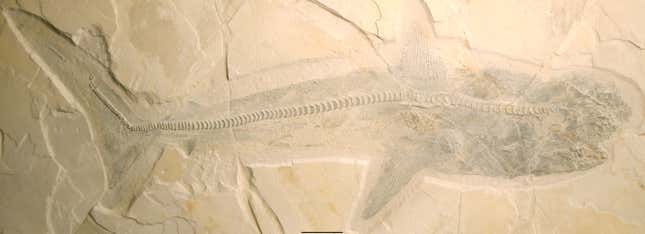The fossil shark Ptychodus was first recognized 190 years in the past, however within the intervening centuries of paleontological inquiry, a complete have a look at the traditional fish has been laborious to return by. Till now. In a paper revealed final week within the Proceedings of the Royal Society B, a staff of researchers describe an exceptionally well-preserved Ptychodus, fossilized from its nostril to the tip of its tail.
Of their analysis, the paleontologists analyzed six near-complete Ptychodus specimens excavated from Vallecillo, Mexico, during the last decade. The specimens reveal the sharks’ skeletal parts in addition to their preserved physique outlines. The staff used the fossils to find out new details about the sharks’ anatomy and their place within the shark household tree.
“This new examine supplies essential data on the affinities [evolutionary relations] and the paleoecology of Ptychodus,” stated Romain Vullo, a paleontologist on the College of Rennes in France and lead writer of the paper, in an electronic mail to Gizmodo. “Up to now, this Cretaceous shark was solely identified from remoted tooth, dentitions [sets of teeth], and some skeletal parts equivalent to vertebrae.”
“The entire specimens from Mexico reveal that Ptychodus was a fast-swimming open water shark (comparable in form to the residing porbeagle), which possible used its grinding dentition to feed totally on ammonites and sea turtles,” Vullo added.
In 2021, Vullo was the lead writer on a paper describing Aquilolamna milarcae, a bizarre-looking Cretaceous period lamniform shark that was excavated from the identical sweep of jap Mexico. Within the latest paper, the staff additionally categorised Ptychodus as a lamniform—a mackerel shark—and posit that the animal’s extinction could have occurred attributable to competitors with mosasaurs, an extinct group of large marine reptiles.
However the actuality could also be extra difficult, as Tyler Greenfield, a paleontologist on the College of Wyoming, defined to Gizmodo. As a substitute of being a mackerel shark, Greenfield suggests Ptychodus belongs to a wholly completely different class.

“Sharks of the order Lamniformes have particular patterns of the configurations and dimensions of the tooth, the hole sections within the jaws that maintain the rows of tooth, and the cartilage constructions contained in the vertebrae that Ptychodus doesn’t have,” Greenfield, who shouldn’t be affiliated with the brand new paper, wrote in an electronic mail. “These options have been ignored by the authors of the brand new paper and so they as an alternative used sure traits of the skull and jaws, which aren’t distinctive to lamniforms, to categorise Ptychodus.”
Greenfield added that, primarily based on similarities between Ptychodus and each Squalicorax and Ptychocorax (two different species of historic shark), the shark household together with Ptychodus and the one together with the latter two species should be positioned in a separate order, Anacoraciformes, or crow sharks.
“Anacoraciformes was named by different authors earlier than me, but it surely has not been used as legitimate since then nor has it included ptychodontids till now,” Greenfield stated, including that the tooth constructed for crushing shelled prey would possible have developed exterior of Lamniformes. “Total, my speculation seeks to construct a extra correct image of the relationships and variety of prehistoric sharks,” Greenfield stated.
One may assume that such immaculately preserved fossils would settle features of the shark’s phylogeny, not complicate it. However no matter how the mud settles relating to Ptychodus’ classification, it’s refreshing—and certainly, extremely lucky—that paleontologists have such well-preserved specimens to make use of in making their determinations.
Extra: Two Bull Sharks Swam Up the Mississippi River All of the Strategy to St. Louis












Leave a Comment